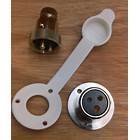Fantasie 19
Well-known member
OK guys - sorry for the dull question, but I can't find any guidance anywhere on this....
I need to re-wire a couple of my waterproof deck plugs - I guess they are the standard, screw down, waterproof, 3 pin (round pins) plugs.. one of the pins - the top one is bigger than the other two... can anyone tell me which is live, which is earth and which is neutral?
There are no markings (I can see) in the plug - and I've worn out google without success - are they laid out in the same way as a mains plug so the bigger pin is earth?

Told you it was dull...
I need to re-wire a couple of my waterproof deck plugs - I guess they are the standard, screw down, waterproof, 3 pin (round pins) plugs.. one of the pins - the top one is bigger than the other two... can anyone tell me which is live, which is earth and which is neutral?
There are no markings (I can see) in the plug - and I've worn out google without success - are they laid out in the same way as a mains plug so the bigger pin is earth?

Told you it was dull...

